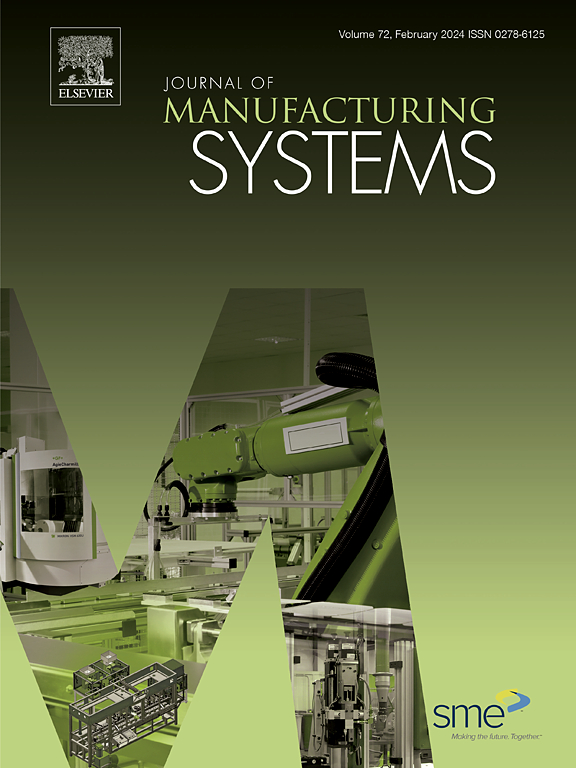Employing deep reinforcement learning for machining process planning: An improved framework
IF 12.2
1区 工程技术
Q1 ENGINEERING, INDUSTRIAL
引用次数: 0
Abstract
Utilizing Deep Reinforcement Learning (DRL) in machining process planning presents a promising avenue to enhance automation, efficiency, and adaptability to diverse scenarios. The definition of the environment plays a crucial role in ensuring the effective application of DRL algorithms, serving as the conduit for formalizing real-world problems into reinforcement learning frameworks. Within the realm of machining process planning, the definition of the environment typically revolves around harnessing components such as processing status, machining operations, and machining resources to reasonably specify the states, actions, reward mechanisms, and other pertinent elements essential for the operation of the DRL algorithm. However, existing DRL-based methods are hampered by various limitations in the definition of the environment. These limitations result in reduced exploration and learning efficiency of the agent, consequently yielding suboptimal machining process planning results. To address these challenges, this paper presents an improved DRL-based framework for machining process planning, specifically targeting aluminum aircraft structural parts. In this context, the framework improves the definition of the state, action, and reward mechanism within the environment, as well as the policy network within the agent. These improvements effectively confine the agent's exploration within a solution space consisting of feasible machining processes for features, thereby mitigating a multitude of invalid explorations and significantly enhancing exploration and learning efficiency. Moreover, these improvements bolster the practical utility of the methodology. In addition, to conduct a more comprehensive exploration for further pursuing optimal solutions, we investigate the incorporation of the Monte Carlo Tree Search algorithm into the proposed framework during the machining process planning phase. Experimental validation conducted on aircraft structural parts demonstrates the efficacy of the proposed method for machining process planning in this domain. Comparative analysis against existing methodologies further underscores the capacity of our framework to generate optimal or near-optimal machining process planning schemes. In conclusion, the proposed framework contributes to advancing machining process planning methods and facilitates wider adoption of DRL within process planning applications.
利用深度强化学习进行加工工艺规划:一个改进的框架
在机械加工工艺规划中利用深度强化学习(DRL)为提高自动化、效率和对各种场景的适应性提供了一条有前途的途径。环境的定义在确保DRL算法的有效应用中起着至关重要的作用,作为将现实世界问题形式化为强化学习框架的渠道。在加工工艺规划领域中,环境的定义通常围绕着利用加工状态、加工操作和加工资源等组件来合理地指定DRL算法运行所必需的状态、动作、奖励机制和其他相关元素。然而,现有的基于drl的方法受到环境定义的各种限制。这些限制导致智能体的探索和学习效率降低,从而产生次优的加工工艺规划结果。为了解决这些挑战,本文提出了一种改进的基于drl的加工工艺规划框架,特别是针对铝制飞机结构件。在这种情况下,该框架改进了环境中的状态、行为和奖励机制的定义,以及代理内部的策略网络。这些改进有效地将智能体的探索限制在由可行的特征加工工艺组成的解空间内,从而减少了大量无效的探索,显著提高了探索和学习效率。此外,这些改进增强了该方法的实际效用。此外,为了对进一步寻求最优解进行更全面的探索,我们研究了在加工工艺规划阶段将蒙特卡罗树搜索算法纳入所提出的框架。通过对飞机结构件的实验验证,证明了该方法在该领域加工工艺规划中的有效性。与现有方法的比较分析进一步强调了我们的框架产生最优或接近最优加工工艺规划方案的能力。总之,提出的框架有助于推进加工工艺规划方法,并促进在工艺规划应用中更广泛地采用DRL。
本文章由计算机程序翻译,如有差异,请以英文原文为准。
求助全文
约1分钟内获得全文
求助全文
来源期刊

Journal of Manufacturing Systems
工程技术-工程:工业
CiteScore
23.30
自引率
13.20%
发文量
216
审稿时长
25 days
期刊介绍:
The Journal of Manufacturing Systems is dedicated to showcasing cutting-edge fundamental and applied research in manufacturing at the systems level. Encompassing products, equipment, people, information, control, and support functions, manufacturing systems play a pivotal role in the economical and competitive development, production, delivery, and total lifecycle of products, meeting market and societal needs.
With a commitment to publishing archival scholarly literature, the journal strives to advance the state of the art in manufacturing systems and foster innovation in crafting efficient, robust, and sustainable manufacturing systems. The focus extends from equipment-level considerations to the broader scope of the extended enterprise. The Journal welcomes research addressing challenges across various scales, including nano, micro, and macro-scale manufacturing, and spanning diverse sectors such as aerospace, automotive, energy, and medical device manufacturing.
 求助内容:
求助内容: 应助结果提醒方式:
应助结果提醒方式:


